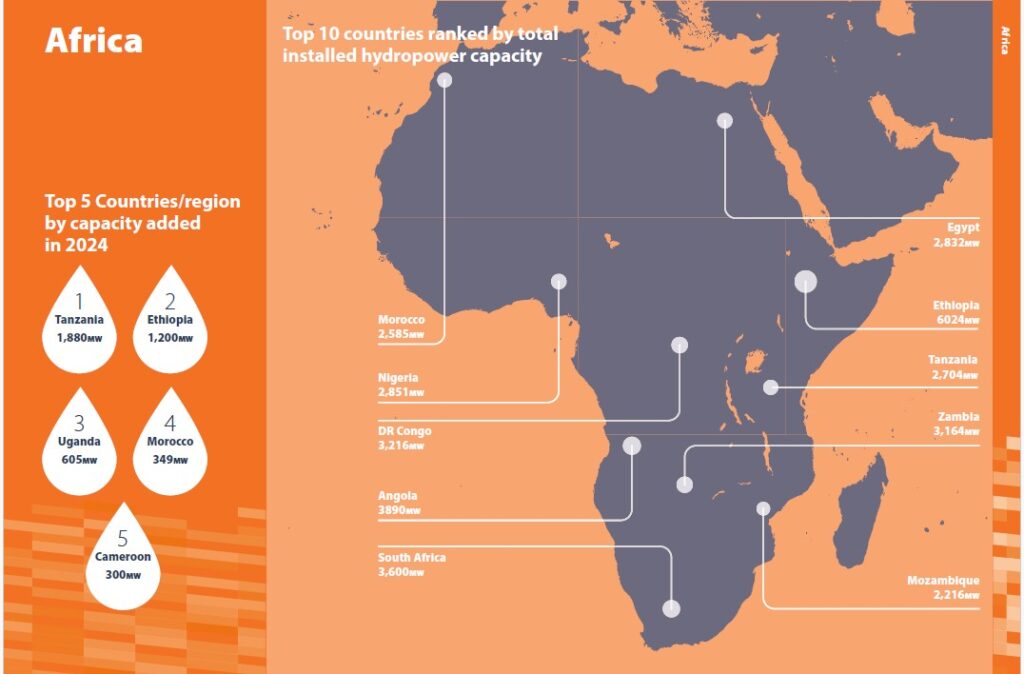The 2025 World Hydropower Outlook, released today, highlights a year of significant progress for hydropower in Africa – with project milestones, increased private sector activity, and a doubling in annual capacity additions pointing to a sector ready to scale.
Africa added over 4.5GW new hydropower capacity in 2024, up from 2GW in 2023. Hydropower now supplies 20% of the continent’s total electricity generation, and with just 11% of technical potential harnessed, the opportunity for future development is one of the most significant in the world.

New project momentum is being driven by a wave of mainly privately developed initiatives, supported by major government-backed schemes. In 2024, several flagship projects reached key milestones: Tanzania’s Julius Nyerere Hydropower Project began operations; the Grand Ethiopian Renaissance Dam in Ethiopia added 800MW with the commissioning of new units; Uganda’s 600MW Karuma plant was fully brought online; and Cameroon completed the 420MW Nachtigal project.
Despite this progress, financing remains the sector’s most pressing constraint. An estimated 62.5GW of approved projects are stalled due to lack of funding, with barriers including offtake risk, foreign exchange volatility, and perceived bankability challenges. Unlocking financing will be essential to realising the continent’s hydropower ambitions.
Beyond new development, the modernisation of Africa’s ageing hydropower fleet is a growing priority. In 2024, the African Development Bank launched the Africa Hydropower Modernisation Programme, with a US$9.72 million budget to support upgrades across 12 privately led projects in eight countries, and technical assessment support from IHA.
Encouragingly, this year’s World Hydropower Outlook shows that global new capacity is accelerating after several years of stagnation. Hydropower is playing an increasingly vital role in the global energy transition. Continued momentum will require bold policy action, including reforms to reward hydropower’s multiple benefits, and faster permitting. And in the face of growing climate volatility, we must build not just clean energy systems, but resilient ones.
Malcolm Turnbull, IHA President
EAs the renewable energy market continues to grow, the story of this year's Outlook is clearly that pumped storage hydropower is at the forefront as the world looks to more energy storage. It also reaffirms that all forms of hydropower remain essential to achieving global climate and development goals.
Eddie Rich, IHA CEO
There is also growing momentum on the ground:
- Angola: The 2,172MW Caluco Cabaça project is under construction, with others in planning. Angola’s energy roadmap aims to grow hydropower capacity from 1,200MW to 9,000MW.
- Nigeria: Mambilla (3,050MW) and other mid-to-large projects are underway. The government’s Sustainable Power and Irrigation Project aims to unlock 10,000MW of capacity through new and existing dams.
- Cameroon: The government has positioned hydropower at the centre of its Emergence 2035 strategy, with major projects like Grand Eweng (1,800MW) in the pipeline.
- A key sustainability milestone was also reached in 2024, as Zambia’s 180MW Ngonye Falls project became Africa’s first hydropower plant to achieve gold certification under the Hydropower Sustainability Standard.
African Hydropower in numbers:
- Generation by hydropower in 2024: 167TWh
- Total installed capacity: 47.3GW
- Capacity added in 2024 (including pumped storage): 4,507MW
- Total pumped storage installed capacity: 3,726MW
Read the full report here.